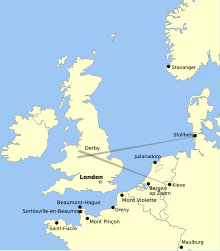Knickebein (radio beacon)
The "Knickebein" method was a radio beacon system used by bombers of the German Air Force to find targets at the beginning of the Second World War . It was developed by the Telefunken company from the X procedure , which in turn was based on the Lorenz landing procedure .
functionality
"Knickebein" was used in German night raids in the early stages of the Battle of Britain . This enabled individual area targets at a distance of 250 km in a target circle of ± 1500 m to be hit with sufficient accuracy.
Unlike the already introduced X-methods were needed for the separate board equipment, used "Knickebein" existing in the aircraft anyway Lorenz - Funk (blind) country systems "FuBl 1" in the frequency range 30 to 33 MHz. For larger target distances later the "FuBl 2" system came with the more sensitive " superheterodyne " -Leitstrahlempfänger type "EBl 3" (instead of the two-circuit - Straight recipient "EBl 1") for installation. Because of the elimination of additional on-board devices that were still required for the X procedure, the radio operators / bombardiers did not need any extensive training for the operation.
Broadcasting stations
For the night air raids on England , three Knickebein transmission stations in Kleve , on the Stollberg and near Maulburg were initially aimed at a town to be bombed, and others were added later. Transmission stations have been set up at the following locations:
| No. | Ø [m] 1 | Location | country | Coordinates | Location description |
|---|---|---|---|---|---|
| K1 | 30th | Klepp | N | 58 ° 46 '12.3 " N , 5 ° 37' 11" E | 22 km south-southwest of Stavanger |
| K2 | 95 | Stollberg | D. | 54 ° 38 ′ 40 " N , 8 ° 56 ′ 40" E | 3 km north-northwest of Bredstedt |
| K3 | 30th | Julianadorp | NL | 52 ° 54 '47.8 " N , 4 ° 43' 0.5" E | 5 km south-southwest of Den Helder |
| K4 | 95 | Kleve - Materborn | D. | 51 ° 47 '19.5 " N , 6 ° 6' 13.2" E | 58 km northwest of Duisburg |
| K5 | 30th | Bergen op Zoom | NL | 51 27 '03 "N 4 18' 00 O | 50 km south-southwest of Rotterdam |
| K6 | 30th | Mont Violette | F. | 50 ° 37 '2.4 " N , 1 ° 40' 56.5" E | 13 km south-southeast of Boulogne-sur-Mer |
| K7 | 30th | Greny | F. | 49 56 '55 "N 1 17' 31" | 16 km east-northeast of Dieppe |
| K8 | 30th | Mont Pinçon north of Le Plessis-Grimoult | F. | 48 ° 58 ′ 31.3 " N , 0 ° 37 ′ 27.6" W. | 30 km southwest of Caen |
| K9 | 30th | Beaumont-Hague | F. | 49 ° 40 '24.4 " N , 1 ° 51' 9.2" W. | 16 km west-northwest of Cherbourg |
| K10 | 30th | Sortosville-en-Beaumont | F. | 49 ° 25 ′ 5.8 " N , 1 ° 42 ′ 32.6" W. | 25 km south-southwest of Cherbourg |
| K11 | 30th | Saint-Fiacre near Plestin-les-Grèves | F. | 48 39 '59 "N 3 43' 49" O | 17 km east-northeast of Morlaix |
| K12 | 95 | Maulburg | D. | 47 ° 38 '2.4 " N , 7 ° 45' 47.9" E | 8 km east-northeast of Lörrach |
| K13 | 30th | Noto | I. | 36 55 '52 N 14 58' 48.90 O | 27 km southwest of Syracuse (not finished) |
Countermeasures
Mainly the British physicist Reginald Victor Jones analyzed the function of the knee-leg system. On June 21, 1940, a specially equipped Avro Anson aircraft of the Royal Air Force recorded radio waves from the territory of the German Reich that crossed over the Rolls-Royce main plant in Derby . There the company mainly manufactured " Merlin " aircraft engines.
In the same year 1940, the process was successfully disrupted by the fact that English radio stations also broadcast the point Morse signal used by the Knickebein systems; this irritated the German pilots and threw many off course. According to Winston Churchill's assessment, the countermeasures in 1940 made a major contribution to reducing the efficiency of German area bombing to below 20 percent.
As a result, the German side reacted to the British disruptive measures. For example, the knee-leg transmitters were activated without an attack taking place or they were only switched on shortly before the start of the attack and the flight destination could no longer be determined in time. Alternatively, many of the systems were put into operation at the same time, so that again the exact destination could not be determined.
However, after the lost Battle of Britain and the abandonment of the Sea Lion company, most of the Luftwaffe's fighter jets were on the Eastern Front anyway.
See also
literature
- B. Johnson: Top Secret - Science and Technology in World War II.
- RV Jones: Most Secret War: British Scientific Intelligence 1939-1945. First published 1978 Hamish Hamilton. Coronet paperback edition 1979 ISBN 0-340-24169-1 .
- Fritz Trenkle : The German radio control procedures until 1945.
Web links
- Crooked leg
- Radio-guidage stations
- Radar stations and specialty radionavigasjonsutstyr in Rogaland 1940–45
- Battle of the Beams: Knuckle Leg
- Radio measurement (location) positions in Germany
- http://www.cdvandt.org/knickebein_fug28a.htm
Footnotes
- ^ War Diary
- ↑ Winston Churchill: The Wizard War . In: Their Finest Hour . Houghton Mifflin Company, 1949, ISBN 0395410568 , p. 343.

